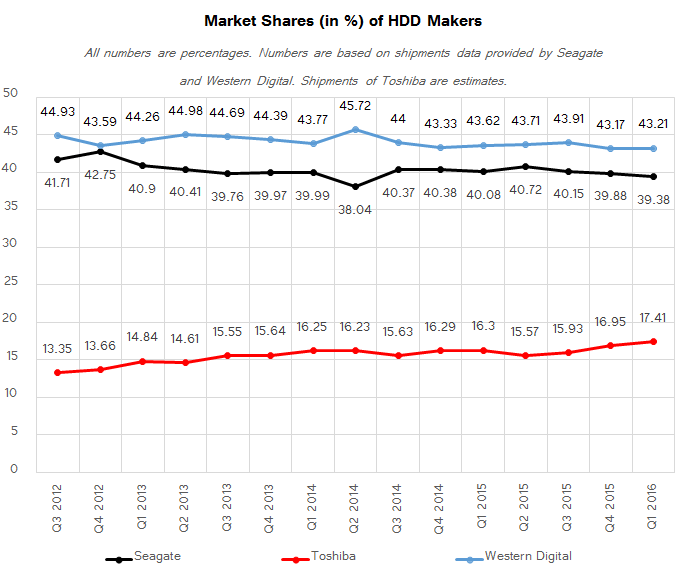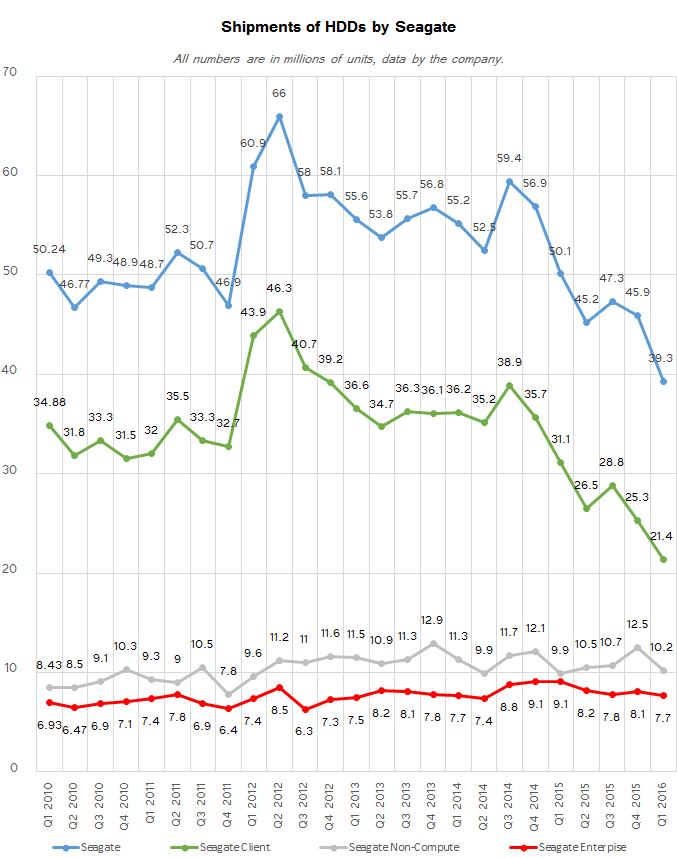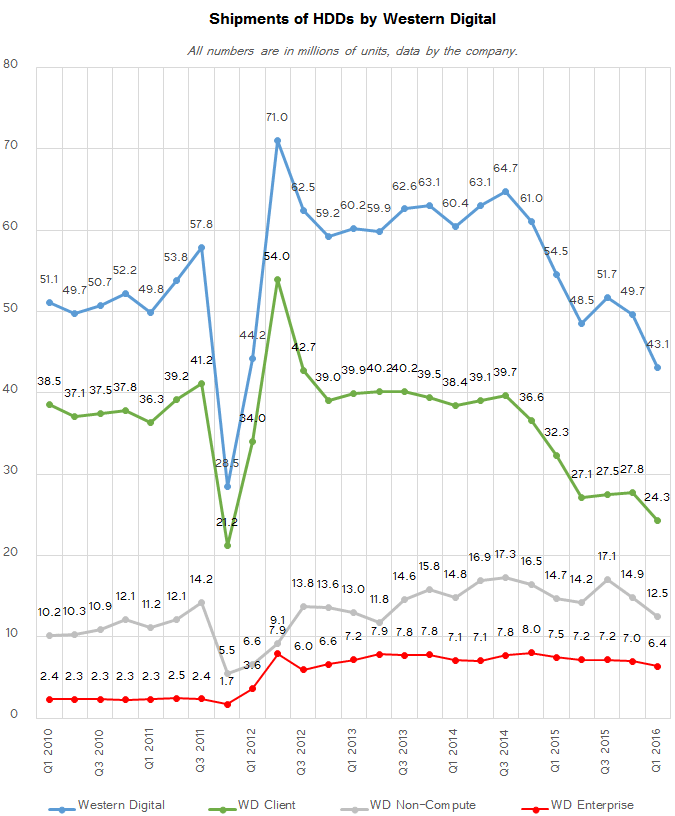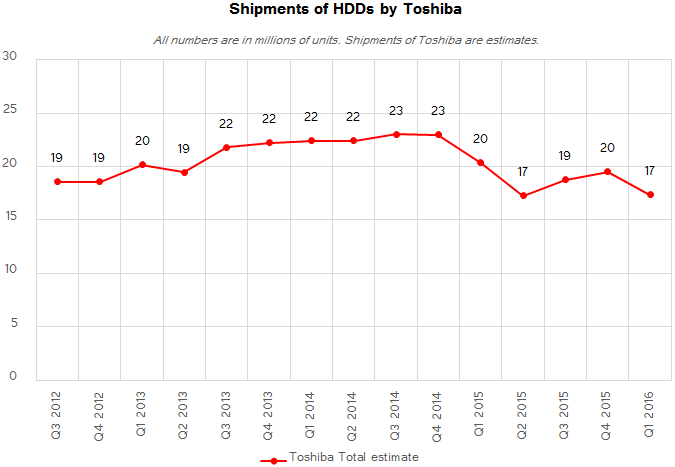Market Views: HDD Shipments Down 20% in Q1 2016, Hit Multi-Year Low
by Anton Shilov on May 12, 2016 8:00 AM ESTWestern Digital Remains World’s No. 1 HDD Supplier
Due to severe declines in demand for hard drives, it does not look like HDD makers want to fight for market share. Western Digital controlled about 43% of the HDD market in Q1 2016, just like a quarter before. Seagate was the second largest supplier with 39.38% market share. If the HDD shipments numbers for Toshiba are correct, then the company controlled around 17% of the hard drive market, moving ever so slightly higher.
Seagate’s HDD Sales Drop Below 40 Million Units, Company Plans Capacity Adjustments, Product Cuts
Seagate sold 39.3 million hard drives in the first quarter of 2016, a 21.5% decline from the same period a year ago. Sales of Seagate’s HDDs dropped across the board - with the exception of nearline drives. During the conference call with investors and financial analysts, the company particularly noted weak sales of client HDDs as well as declines in shipments of traditional mission-critical drives. Moreover, in a bid to maintain margins, the firm decided to “not aggressively participate in certain areas of the low capacity notebook market,” which further drove its unit sales down.
As it appears, Seagate does not seem to be confident that the hard drive market will rebound in the foreseeable future. The HDD maker intends to cut-down its manufacturing capacities from 55 – 60 million units per quarter to approximately 35 – 40 million units per quarter, which will help it to reduce operating costs and maintain prices despite competition from traditional and emerging rivals.
“In the March quarter we began the process of reducing our HDD manufacturing capacity from approximately 55 million to 60 million drives per quarter to approximately 35 million to 40 million drives per quarter,” said Steve Luczo, chief executive officer of Seagate, in a conference call with investors and financial analysts. “The actions required will be completed within the next 6 to 9 months. At the same time, we will continue to accelerate the utilization of our own drive factories internally and media facilities.”
While Seagate does not detail its capacity-cutting plans, it indicates that it intends to shift build volumes to its higher capacity models, which will simplify wafer requirements, optimize the lineup and will eventually reduce costs. In particular, the company will discontinue some of its low-capacity client HDDs (250 GB, 320 GB and 500 GB), which will help to increase its ASPs (average selling prices) and margins.
“In [Q1 2016] we began end-of-life activity on some of the older 500 GB and below products that have very low margins,” said Dave Mosley, president of operations and technology at Seagate. “Most of the margin cost benefits of these products will be realized over the next few quarters.”
In fact, Seagate began targeted pricing increases across its product portfolio already in the third quarter of its fiscal year (i.e., Q1 2016), which could help to improve its financial results. The manufacturer believes that higher HDD prices are justified because HDDs are getting harder to make. Since the company decided not to participate in some areas of the low capacity laptop market, it is evident that it may leave it to makers of entry-level SSDs in the future.
“In the March quarter we initiated targeted pricing increases across our product line, we were successful in some areas and unsuccessful in other,” said Mr. Luczo. “We continue to believe the industry needs a stable pricing environment to deliver the higher level of requirements being placed on our products and to realize the value we are providing to the market. As a result, we will continue to pursue a pricing strategy that reduces and properly reflects the investment in technology the market requires.”
Shipments of Western Digital’s HDDs Fall to 43.1 Million Units
Western Digital shipped 43.123 million of HDDs in the first three months of this year, or 21% less compared to Q1 2015. Sales of the company dropped across the board due to the weak PC market and seasonality. Just like Seagate, Western Digital increased prices of certain products during the quarter. In particular, the company hiked prices of some of its 2.5” drives for notebooks and gaming PCs (which is probably the WD Black2 Dual Drive). Right now, the company is making selective price increases in the enterprise segment in a bid to maintain its ASPs and margins and sustain its ability to invest in the development of products.
“Because we want to make sure that we have got sufficient dollars to reinvest back into our business to continue to innovate and provide compelling products for our customers, we are making selective price increases in certain enterprise markets,” said Stephen Milligan, chief executive officer of Western Digital, in a conference call with investors and financial analysts. “At this point, we are not sure if they're going to stick, but we are certainly hoping that they do.”
Earlier this year Western Digital announced plans to optimize its roadmap and close-down its head wafer manufacturing facility in Otawara, Japan, in a bid to reduce costs and maintain its profitability. So far, the company has not announced plans to reduce its HDD manufacturing capacities significantly but said it would eliminate redundant facilities. The company also did not make any comments regarding the future of its low-end HDDs.
Toshiba’s HDD Shipments Drop Too
Since Toshiba does not disclose anything related to its hard drive business, it is hard to analyze this supplier. If estimations of HDD makers and Nidec are correct, then Toshiba’s HDD shipments in Q1 2016 should be around 17 million units, or 15% below its shipments in the same period last year.














116 Comments
View All Comments
Wolfpup - Thursday, July 14, 2016 - link
No it isn't. 1TB is nothing if you're having to pull in this kind of data. Hell, a lot of new games are about 50GB a piece now.seerak - Monday, May 16, 2016 - link
Or screwups like this onehttp://www.snopes.com/apple-music-deleting-files/
Wolfpup - Thursday, July 14, 2016 - link
Yeah, Comcast is rolling their caps out wider starting NEXT MONTH. They're the largest ISP, so....will792 - Thursday, May 12, 2016 - link
I have numerous friends with rapidly growing repository of video and image files (NEF files for Nikon D800 are 30-35MB each). Hard drives are the only realistic option to store multi terabyte libraries of created content that is typically mirrored and backed up. Proliferation of video created with GoPro or other action video cameras (including drone mounted cameras) will force consumers to buy hard drives since upload speed of typical Internet connection is too slow for upload of high resolution video content.Murloc - Thursday, May 12, 2016 - link
at the end of the day, not a high % of people do that kind of stuff even though it's gotten more popular over the year.Just about everybody I know owns a laptop. If those increasingly come without HDDs but with SSDs, that's gone, RAW photographers or not.
DanNeely - Thursday, May 12, 2016 - link
In the medium term I wouldn't be concerned about disks for photography (or other bulk storage). The 3.5" HDDs best suited for USB drives/NASes are most similar to enterprise nearline storage drives; which as a segment dominated by cost/gb should be the most resilient part of the HDD market. Until/unless flash becomes cheaper per GB they're unlikely to go away.The short term situation of bottom end consumer drives being in freefall doesn't really matter beyond headline sales figures. The margin on those drives is near zero, so losing them doesn't affect the bottom line much (and that primarily from one time costs related to scaling down production capacity).
I wouldn't worry until sales for 10/15k SAS drives start plummeting as well. They have the highest margins and fund an out-sized share of the R&D needed to develop higher capacity drives. When that goes away we'll either see a significant slowdown in capacity growth or rise in prices to sustain R&D spending (or both). That will probably be the beginning of the end for HDDs by making it much easier for flash to catch up in price/GB.
tamalero - Tuesday, May 17, 2016 - link
arent 10k 15k sas drives being replaced by SSDs in the corporate level?FunBunny2 - Thursday, May 12, 2016 - link
yeah. what drove the first PC period was Word/Office at home, likely pirated from work. no one has ever had much need for more than 640K until the recent gaming fiasco. windoze bloated up, which drove it, too. but that has ended. we're now in the Times of Good Enough.Michael Bay - Thursday, May 12, 2016 - link
>gaming fiasco>windoze
Don`t forget to take your meds, please.
Wolfpup - Thursday, July 14, 2016 - link
<<< no one has ever had much need for more than 640K>>>(!) Uh... Are you in the right decade?
And what's a "gaming fiasco"?